Dev Blog - How to build a holodeck, week 13
I’ve always wanted to play God, and I’m a huge fan of god games. One prototype I’ve had on my list to make for a while is some form of solar system formation simulator. I’ve taken a very early stab at it this week, with some lessons learned.
TL;DR
But first, a quick catchup …
Very early in the week, I managed to get voice comms working in the portals prototype. That’s awesome, and it means I can move on to testing multiple people interacting (somehow) in the same space (somewhere).
The initial networking tests last week used a smiley face sphere, and having that kinda-looking at you and talking at the same time “works” (for some value of works) but it’s not particularly compelling - it’s better than a telephone call, but it’s not crazy immersive “I felt like I was there”.
When I’ve managed a very rough first pass of something, I often hit a bit of a mental block as to how to refine it. Rather than going for the next obvious piece of the puzzle (avatars, for more realistic human presence) I thought I’d take a bit more time to investigate controllers, and also think more about what kind of information I’m going to send over the network.
Networking, determinism and latency
I’ve written a few networked games in my time, both realtime and turn based. Multiplayer realtime networking is another one of those challenging areas that it’s pretty darned hard to get right, but it’s also an area where the architecture of the solution you pick will mould and inform the rest of the codebase. Dropping in Photon and copying their demo examples has gotten me up and running, but I need to think properly about my strategy for passing information between participants.
Determinism is pretty important in multiplayer games - you want all clients to respond in the same fashion to the same inputs, regardless of who they are coming from. Having a server arbitrate is the normal way to do this, but you can do this on one of the clients if the load isn’t too high. You need to ensure that everyone performs the same actions at the same point in time, and any randomness is the same on each client when the action is performed. It’s possible Photon has good tools to help this, so that’s next up on the research list. If not, I’ll probably be writing some form of command stream over the network, as synchronising all the state I want to chuck around will get pretty expensive pretty fast; I’m looking at 30-40 transform nodes per person for their skeleton, plus controller transforms and an array of input feeds.
Latency is also going to be a big player in the holodeck - I’m looking at more than 200ms right now with local tests, and we’ve all experienced the kind of delays you get on a transatlantic phone call or watched a live news broadcast where the delay can top a second or more. This is impossible to mitigate below the base level, but I need to ensure that all local actions are immediate, but appear synchronised to all the other clients, so I’ll need to put some serious thought into structuring the data transfer around this.
Physical simulations
As soon as you start putting moving objects into the environment, you have to start figuring out how to synchronise those over the network, so that seemed like a great test for the week. I’ve also put in some basic Vive wand controller wrappers so I can easily get the wand states. Hopefully I’ve written this in a nice enough way that putting in Leap Motion as a controller will also work - that will let me move over to Tango as a test environment for interactions. I’m currently limited in the number of folks who both possess a Vive and are close enough to physically meet! Hopefully that’ll change over the course of this year.
I’ve been messing around with a couple of cool game ideas which incorporate physics, but I’ve always wanted to make a solar system, and I’ve never really played with physics in 3D before, so I’ve built a very simple gravity simulation. Check out the video above, and if you’d like to try it on the Vive, drop me a mail and I’ll send a link to the exe.
There’s something quite magical about putting a thing in orbit around another thing. I guess this is the kind of fun you can have up in the space station, but it’s certainly a first for me to be able to do this. It’s a viceral realisation of something that’s always been a mathematical notion. 2D games (or 3D games on a 2D screen) can obviously portray gravity and physics, but stepping inside it is really something different.
Having this work across the network will be a challenge, but I’m a fan of challenges, and hopefully it’ll teach me all the stuff I need to know to get the avatars synching properly.
Next week …
Next week is “taking stock” week. I’ve been on a three month trial with myself, finding out if I can survive and be productive outside the structure of an established studio. It’s been a real journey so far, and it’s time to decide what the plan is for the remainder of the year.
I’ll be looking at reaching out to interested folks to participate (local testers initially) - If you’re up for getting involved, drop me a mail!
